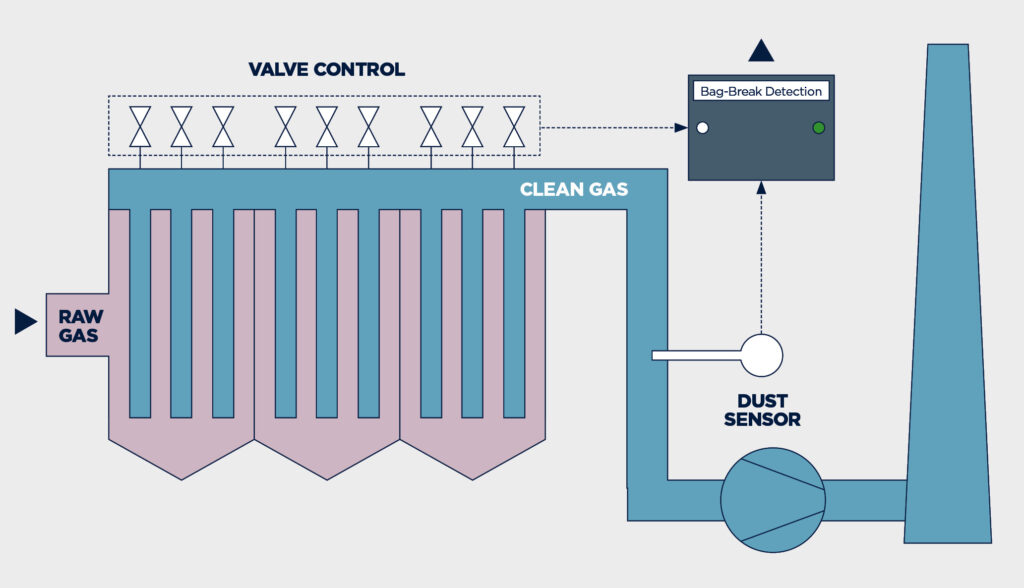Primetals Technologies has developed a variety of sensor solutions for steelmaking. These sensors generate the data required for condition monitoring, and play an important role in determining necessary maintenance efforts. They contribute to the proactive prevention of standstill times, and improve overall production-process reliability. In this overview, we have selected three sensor packages to illustrate the wider commitment of Primetals Technologies to comprehensively digitalize the steelmaking production stage.
Bag-Break Detection System
The Bag-Break Detection System continuously monitors the status of filter elements in a pulse jet filter. By measuring the dust at the filter exit, damaged filter elements can be detected and localized.
The system also allows for integration with the condition-monitoring system of Primetals Technologies, so that a precise analysis of the state of the filter bags attached to a valve can be conducted.
The system therefore plays a crucial role in terms of ongoing maintenance and improving cleaning efficiency, as it allows damaged filters to be replaced as necessary. Consequently, the time and money spent on identifying damaged filter bags can be significantly reduced.

Spark-Detection System
Sparks or flames in exhaust gas ducts can cause considerable damage to upstream machinery. For instance, sparks can cause significant damage in pulse-jet bag-filter systems if they are not identified in time, or at all. Damage to the hoses can cause a direct increase in exhaust gas emissions, which means taking the relevant chamber out of commission in the worst-case scenario. This could result in a production stop to allow for the damaged filter bags to be repaired. The Spark-Detection System of Primetals Technologies not only handles spark detection fully automatically; it is also a spark-extinguisher system for all types of exhaust pipes. Because the system takes measurements within the infrared spectrum, reliable detection can be guaranteed even in extreme darkness or where the situation is complicated by the accumulation of dust or very-high-volume flow rates. Integration with a condition monitoring system (such as Primetals Technologies’ BOX Concept, see pg. 34) is also possible with this product, thanks to spark counters or spark-extinguisher status signals.
Slop-Over Prevention System
The Slop-Over Prevention System was created for ladle-transfer cars. Given that steel at 1,600°C is as fluid as water, any overly jerky movements will cause slop over, which greatly increases the risk of significant damage and danger. To minimize the risk to staff and equipment, Primetals Technologies has developed a slop-over prevention system for ladle-transfer cars that uses a model-based ruleset for acceleration and deceleration curves, in order to effectively reduce the risk of slop over.

Interview with
Andreas Rohrhofer
Andreas Rohrhofer is part of the development team at Primetals Technologies for sensor-based products in steelmaking.
How has the recent push for increased digitalization promoted the development of new sensor solutions?
Rohrhofer: Digitalization has forced us to come up with new sensor strategies and concepts. Virtual sensors, for instance, allow new measurements and calculations to be made by linking existing sensors without having to install new hardware. This new sensor strategy minimizes any disruption to the equipment and keeps design costs low.
What are the challenges in the creation of new sensor solutions for steelmaking?
Rohrhofer: The best sensor is one that we will no longer need in the future, because it will have been superseded by mathematical models and software. Therefore, we have to work hard to properly recognize physical correlations in the process and to derive a mathematical relationship from that.
Is there any one recent sensor-related project that you find particularly intriguing?
Rohrhofer: The measurement of temperature and oxygen content using submersible probes is crucially important in steelmaking. Lance Guard ensures that the associated sensors are monitored and deliver accurate readings for production and process models.


